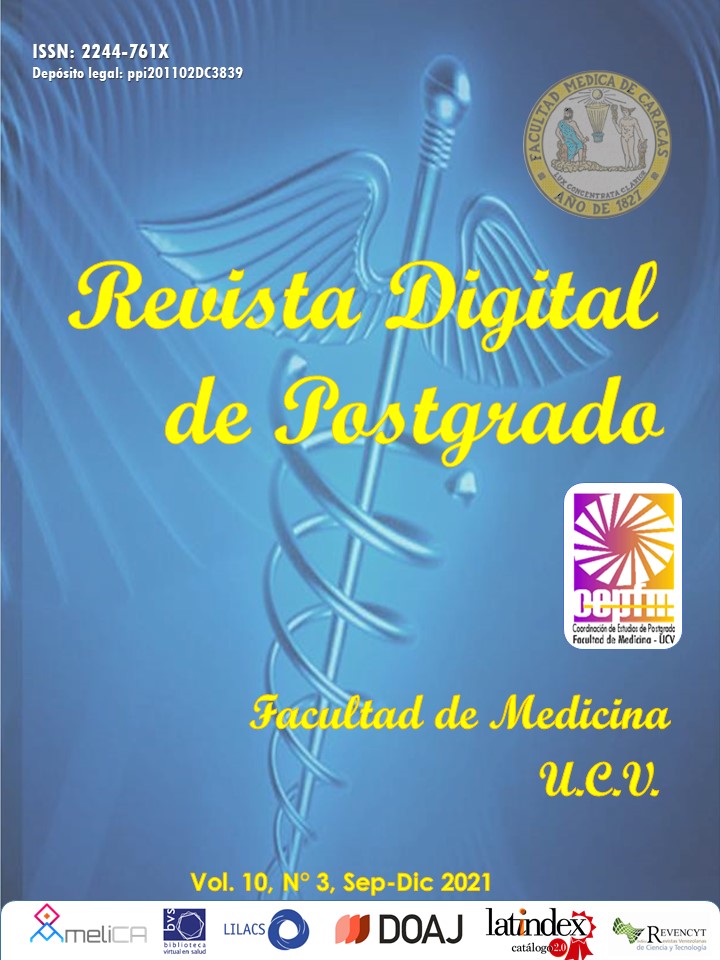Lifestyle of children and adolescents with Down syndrome: case study
Keywords:
Down syndrome, lifestyle, nutritional status, eating habits, personal habits, physical activity, children, adolescents.Abstract
Objective: To determine the lifestyle of children and adolescents with Down Syndrome. Method: A descriptive, prospective, analytical and cross-sectional case study, carried out on a sample of 13 children and adolescents between 4 and 14 years of age with Down Syndrome from the Simón Rodríguez Institute of Special Education, Municipality of Independencia. Miranda State. Anthropometric measurements (weight and height) were made and a structured questionnaire was designed into open and closed questions, which was applied to parents and guardians. Results: The sample made up of 76.9% of the male sex and 23.1% of the female sex, average age range of 9.23 ± 3.32. They belong to socioeconomic stratum IV. According to the nutritional diagnosis, 38% classified normal weight with normal size, 15% as normal weight with tall size, 8% as normal weight with short height and overweight as tall and short; 18% at risk of mild deficit with normal size and 15% in deficit with normal size 18%. The structure of the diet is classified as highly protein 26,3%, low in fat 7,5% and adequate in carbohydrates 67,3%. The adequacy of the diet revealed that in a higher percentage it is inadequate due to excess 46%, followed by inadequate deficit 38% and adequate 16%. Mostly they do physical activity, nap and have adequate personal hygiene habits. Conclusions: This research allowed characterizing children and adolescents from the socioeconomic, nutritional, personal and eating habits and physical activity points of view.
Keywords:
Downloads
References
Moraga F, Atalah E. Diagnóstico y manejo nutricional de pacientes con Síndrome de Down. Medwave. 2006; 6(6).
Velazco Y. Propuesta de un instrumento de evaluación de la calidad de la dieta en niños de 4 a 6 años. Trabajo de ascenso para ascender a la categoría de Asistente. Escuela de Nutrición y Dietética. Facultad de Medicina. Universidad Central de Venezuela; 2000.
Méndez-Castellano H., Méndez MC. Estratificación social y biología humana: Método Graffar modificado/ Arch Venez Pueric Pediatr. 1986; 49(3/4):93-104.
Méndez-Castellano H. Sociedad y estratificación: Método Graffar-Méndez Castellano. Ediciones Fundacredesa, Caracas; 1994.
Pastor L X, Quintó M, Corretger R, Gassió M, Hernández A. Tablas de crecimiento actualizadas de los niños españoles con Síndrome de Down realizadas por la Fundación Catalana Síndrome de Down. Revista Médica Internacional sobre el Síndrome de Down. Serés SD- DS. 2004; 8:34-46
World Health Organization. Referencia de crecimiento 5-19 años. IMC para la edad (5-19 años). 2019; (Citado 20 abril 2019). Disponible desde: https:// www.who.int/growthref/who2007_bmi_for_age/en/
Fundación Bengoa. Valores de Referencia de Energía y Nutrientes para la población venezolana, Revisión 2012. (Citado 16 Abril 2018). Disponible en: https://www.fundacionbengoa.org/publicaciones/Actualizacion-valores-de-referencia-Venezuela.pdf
Núñez L, Fuentes M, López AV, Figueroa O, Soto I. Crecimiento y Estado Nutricional de niños Venezolanos con Síndrome de Down. Premio” Fundación Patronato Hospital de Niños J.M. de los Ríos”. LII Congreso Nacional de Pediatría. Archivos Venezolanos de Puericultura y Pediatría. 2006; 69(4): 161-67
Beledo FJ, Rodríguez RE. Capítulo II: Síndrome de Down. Fundación Síndrome de Down de Cantabria, 2006; p.47-56. (Citado 21 noviembre 2017) Disponible desde: http://ardilladigital.com/DOCUMENTOS/DISCAPACIDADES/ PSIQUICA/SINDROMES%20Y%20APOYOS%20-%20FEAPS%20-%20libro/03%20 capitulo02%20Sindrome%20de%20Down.pdf
Melicia C. Whitt-Glover KL., O’Neill NS. Patrones de actividad física en niños con y sin Síndrome de Down. Pediatric Rehabilitation 2006; 9(2):158-164. (Citado 15 septiembre 2019) Disponible en: https://www.down21.org/678-revista-virtual/revista-virtual-2006/revista-virtual-mayo-2006/resumen-mayo-2006/2036-patrones-de-actividad-fisica-en-ninos-con-y-sin-sindrome-de-down.html
Blanco M. Atención y cuidados odontológicos para los niños con Síndrome de Down. Buenas prácticas Revista Síndrome de Down. 2005; Marzo. (22): 15. (Citado 18 agosto 2019). Disponible desde: http://www.downcantabria.com/revistapdf/84/15-19.pdf
Instituto Nacional de Nutrición. El Trompo de los Alimentos Democratizando la Cultura Alimentaria y Nutricional; 2014 (Citado 22 febrero 2018). Disponible desde:http://www.inn.gob.ve/innw/wpcontent/uploads/2014/02/ Trompo_de_los_ Alimentos. pdf
How to Cite
Issue
Section
License
Usted es libre de:
- Compartir — copiar y redistribuir el material en cualquier medio o formato
- Adaptar — remezclar, transformar y construir a partir del material
- para cualquier propósito, incluso comercialmente.
Bajo los siguientes términos:
-
Atribución — Usted debe dar crédito de manera adecuada, brindar un enlace a la licencia, e indicar si se han realizado cambios. Puede hacerlo en cualquier forma razonable, pero no de forma tal que sugiera que usted o su uso tienen el apoyo de la licenciante.
- No hay restricciones adicionales — No puede aplicar términos legales ni medidas tecnológicas que restrinjan legalmente a otras a hacer cualquier uso permitido por la licencia.











